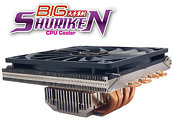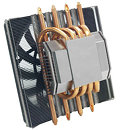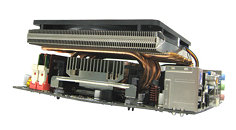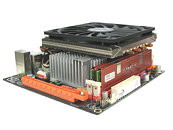- Joined
- Oct 9, 2007
- Messages
- 47,886 (7.38/day)
- Location
- Dublin, Ireland
| System Name | RBMK-1000 |
|---|---|
| Processor | AMD Ryzen 7 5700G |
| Motherboard | Gigabyte B550 AORUS Elite V2 |
| Cooling | DeepCool Gammax L240 V2 |
| Memory | 2x 16GB DDR4-3200 |
| Video Card(s) | Galax RTX 4070 Ti EX |
| Storage | Samsung 990 1TB |
| Display(s) | BenQ 1440p 60 Hz 27-inch |
| Case | Corsair Carbide 100R |
| Audio Device(s) | ASUS SupremeFX S1220A |
| Power Supply | Cooler Master MWE Gold 650W |
| Mouse | ASUS ROG Strix Impact |
| Keyboard | Gamdias Hermes E2 |
| Software | Windows 11 Pro |
Japanese cooling specialist Scythe is readying a new variant of the Shuriken CPU cooler, this time of a slightly larger built, while respecting its design ideology that it should be slim form-factor friendly. The Big Shuriken differs from Shuriken in its dimensions, fan size, and number of heat-pipes. It measures 125 × 135 × 58 mm, and holds a slimmer 120 mm fan, in comparison to the Shuriken having a 100 mm fan, and a height of 64 mm, which is slightly higher.
The basic construction remains the same: from a CPU contact base that doubles up as a heatsink, originate four copper heat-pipes, that convey heat to a dense array of aluminum fins, which is directly under the air-flow of the fan. The PWM-controlled fan spins at speeds of 650~1600 rpm, pushing 15.77~38.05 CFM of air, with noise outputs ranging in 12.91~28.89 dBA. The cooler weighs in at 405 g (around 0.9 lbs), and is compatible with most existing desktop CPU sockets including LGA-1366/775, and AMD AM3/AM2+/AM2/939. There is no word on its global availability and price yet.




View at TechPowerUp Main Site
The basic construction remains the same: from a CPU contact base that doubles up as a heatsink, originate four copper heat-pipes, that convey heat to a dense array of aluminum fins, which is directly under the air-flow of the fan. The PWM-controlled fan spins at speeds of 650~1600 rpm, pushing 15.77~38.05 CFM of air, with noise outputs ranging in 12.91~28.89 dBA. The cooler weighs in at 405 g (around 0.9 lbs), and is compatible with most existing desktop CPU sockets including LGA-1366/775, and AMD AM3/AM2+/AM2/939. There is no word on its global availability and price yet.




View at TechPowerUp Main Site










